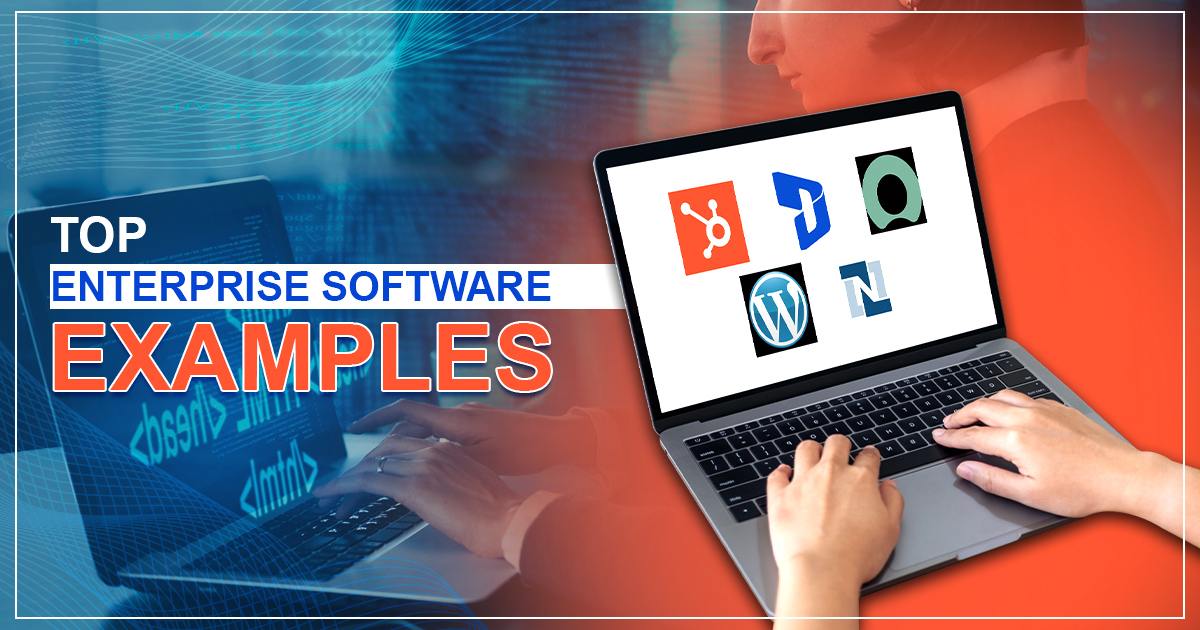With improvements in workplace collaboration, data collection, and innovations, it’s vital for organizations to ensure every aspect of their operation works in union. Organizations or companies can use enterprise software to streamline and facilitate these processes.
Undoubtedly, we are here to help you at all stages of software planning and implementation. However, you must be aware of some amazing examples of enterprise application software in the industry.
If you are also looking for inspiration to create your own enterprise solutions, we are here to guide you through this journey.
What Is Enterprise Software?
Enterprise software, also known as EAS (enterprise application software), helps with an organization’s overall needs rather than individual users’ needs.
Multiple organizations use EAS, including schools, clubs, businesses, charities, governments, and interest-based user groups. Due to its nature, it is vital for EAS to support multiple users with different roles in pursuit of organizational objectives.
Enterprise application software needs a high degree of scalability and interdisciplinary skills to analyze and manage huge sets of data. Enterprise software helps organizations to centralize information, saves money & time, improves security, promotes collaboration, increases scalability, monitors performance, and reduces human error.
There are various types of enterprise software, including:
- Enterprise Resource Planning (ERP).
- Business Intelligence (BI).
- Customer Relationship Management (CRM).
- Human Resource Management (HRM).
- Marketing Automation.
- Supply Chain Management (SCM).
- Business Process Management (BPM).
- Content Management System (CMS).
- Knowledge Management.
- Business Process Automation.
- Project Management.
Best Enterprise Software Examples:
In this article, we list down the topmost-performing examples of enterprise applications from multiple categories. Most of these have exceptionally amazing results. So, let’s dive into some interesting information about them.
Microsoft Dynamics 365
One of the best enterprise software examples is Dynamics 365. It allows entrepreneurs to track customer data, manage operations, generate more leads while offering enhanced services, and resolve problems faster.
This cloud-based enterprise resource planning tool simplifies multiple tasks related to e-commerce, warehousing, distributing, and more, even when offline. As a result, many entrepreneurs prefer using this mobile app for CRM and ERP support.
Many popular small, medium, and large-sized businesses from multiple industry verticals use Dynamics 365. These include UNICEF, Starbucks, Mercedes-Benz USA, etc.
According to a survey by Enlyft, approximately 65,668 companies use Dynamics 365, with the majority of users having between 50-200 employees and approximately $10 million and $50 million in revenue.
Category:
- Business intelligence
- Enterprise resource planning
- Customer relationship management
Key Features:
- Customer service dashboard
- Complete visibility and control
- Sales & customer insights
- Integration with Microsoft products
HubSpot
HubSpot serves largely as a CRM by helping its customers with content management, inbound marketing, customer service, and sales automation. It is a good example of enterprise software with reliable, interactive features like email tracking, meeting scheduling, live chat, etc.
HubSpot is a popular option for small businesses because it’s an all-in-one platform that helps companies expand their businesses. It is customizable and easy to use.
Some popular HubSpot users are Shopify, Spotify, Zoom, Canva, Trello, and, of course, HubSpot itself. More than 184,000 organizations use HubSpot to automate and scale operations.
Category:
- Customer relationship management
Key Features:
- Client retention
- Analytical insights
- Lead conversions and tracking
- Website integration
ServiceNow
A cloud-based workflow automation platform, ServiceNow helps organizations conduct digital workflows for enterprise software operations. It offers a single platform for managing human resources, customer service, IT services, and other business processes.
ServiceNow allows entrepreneurs to improve their business operations while it unites vital functional aspects like customer and security services. This software can also automatically prioritize and assign work based on the availability of human resources and the organization’s financial capability.
ServiceNow is used by well-known enterprises, including Adidas, PayPal, and 85% of the Fortune 500 companies. It is also one of the leading IT service management platforms. Additionally, it is gaining traction in some other areas as well, such as human resource management and customer service management.
Category:
- Workflow automation
Key Features:
- Asset management
- Incident management
- Knowledge base and self-service portal
- Process changes to IT systems
WordPress
WordPress is one of the most outstanding content management systems worldwide. It has over 63% market share and more than 43% of websites. It’s easy and free to use, allowing users to build websites and seamlessly manage content.
Anyone can create and customize portfolios and blog posts to fit particular business needs. Additionally, it comes with a mobile version that simplifies editing, creating, and also publishing posts in real-time.
Because of this platform’s scalability, flexibility, and ease of use, many well-known companies use WordPress. These include Spotify Newsroom, Mercedes Benz, TechCrunch, etc.
Category:
- Content management system
Key Features:
- Real-time editing
- Pre-built templates
- Post creation & scheduling
- Auto-update
- Template management
DropBox
Dropbox is a cloud storage service that allows users to store files online. Users can easily access those files from anywhere with an internet connection. With over 700 million registered customers, this platform proves that it is one of the most popular cloud services worldwide.
This extremely secure platform makes it easy to manage and store files, libraries, and backups in one place. Every file is accessible on various devices.
Therefore, collaborating with clients and accessing work-related resources are pretty easy. Additionally, it comes with an effective scanning feature that allows you to scan receipts or take videos or photos for backup.
Category:
- Cloud computing
Key Features:
- Cloud storage
- File sharing across multiple devices
- Encryption security
- Content collaboration
Asana
When we are talking about the top enterprise software examples, this name shouldn’t be missed. It is a SaaS-based project management platform. Asana allows organizations to efficiently manage and track their work.
By bringing all vital resources together in one place, Asana saves time and prevents the inconvenience of shuffling between files, spreadsheets, and emails to track work.
Asana is very popular among big organizations. 400 of the top engineering and architecture firms use Asana to manage their work and projects. Other notable companies using this platform include Pinterest, Robinhood, Instacart, CRED, etc.
Therefore, Asana is a platform that is rich in scalability and can also be used to manage complex workflows and projects.
Category:
- Project management
Key Features:
- Team management
- Task automation
- Better collaboration
- Reporting
NetSuite
Another cloud-based enterprise resource planning software, NetSuite, helps businesses of every size to manage their core processes. It includes customer relationship management, accounting, supply chain management, order management, production, and inventory management.
NetSuite features a single yet integrated suite of applications so that businesses can manage every process and operation from only one place. This helps reduce costs, streamline operations, and improve efficiency.
With NetSuite, supply chain management becomes easier. You can view the product journey from manufacturing to delivery to customers. It also helps you track inventory so that every material is stocked and analyzes the required workforce.
Because of its capabilities to enhance workforce efficiency and data accuracy, NetSuite is one of the best examples of enterprise software. It is used by over 40,000 companies in the world including Cisco, Tableau Software, Deloitte Digital, etc.
Category:
- Supply chain management
- Customer relationship management
- Enterprise resource planning
Key Features:
- Data export & import tools
- Order management
- Payment processing
- Customized invoicing
- Output document generation
Conclusion
The industry has plenty of real-life examples of enterprise software that have brought and continue to bring high revenue and overall growth for organizations. While this blog gives you an idea of what solutions can help your enterprise, looking for a trustworthy software development partner is essential.
FAQs
The 3 main enterprise systems are customer relationship management, enterprise resource planning, and supply chain management.
ERP is a software system that allows users to run an entire business. It supports automation and processes in finance, supply chain, manufacturing, and more.
Some of the examples of enterprise software are HubSpot, NetSuite, BambooHR, InFlow, WordPress, etc.
The major difference is that enterprise software is more complex than desktop software.
Also Read About: Top 10 Reasons Why Website Maintenance is Essential




